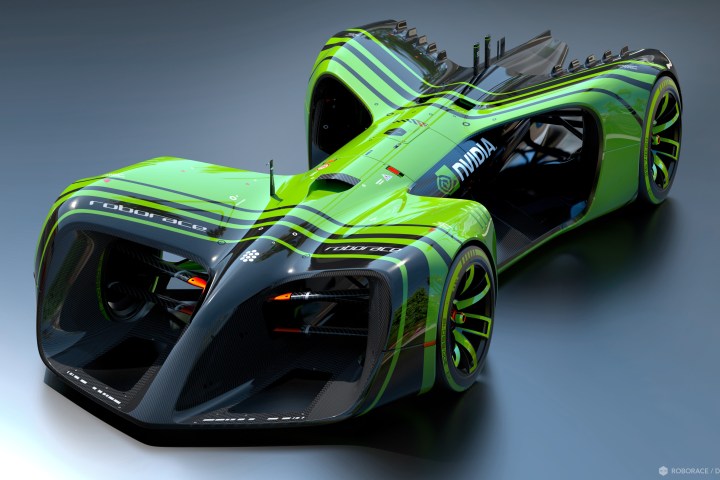
For starters, the Roborace Championship, first reported on Digital Trends here, is part of the Formula E ePrix “electric” racing series, meaning the racecars are driverless and utilize alternative “earth-friendly” energy sources. These one-hour races consist of ten teams that use two identical cars packing Nvidia’s Drive PX 2. Because these cars don’t rely on driver intuition to win, the teams must program the AI to be highly strategic.
According to Nvidia, the Drive PX 2 supercomputer is the size of a lunchbox, keeping with the overall compact design of the cars. The Drive PX 2 is also capable of up to 24 trillion operations a second for AI applications, thus providing “supercomputer-class” performance, or the processing power of 150 MacBook Pro laptops. And because of its deep learning capability, the cars will become smarter — and thus faster — the more they actually race.
“Since the cars don’t need human drivers, these racecars are incredibly compact, and the designs — conceived by auto designer Daniel Simon, the man behind Tron: Legacy’s light cycles — are like nothing that’s been seen on a road, or a racetrack, before,” Nvidia’s Danny Shapiro said in a blog. “There’s no room in these racers for the trunk full of PCs that powered earlier generations of autonomous vehicles.”
Nvidia says the Drive PX 2 is capable of incorporating input from a number of sensors installed in the racecar such as GPS, cameras, radar, and more. Ultimately, the Drive PX 2 supercomputer and the Roborace Championship races should lead to smarter and safer driverless and standard cars for public consumption.
As for those high-definition maps mentioned in Tuesday’s keynote, the system will enable the rapid development of HD maps and frequent updates through the use of the Drive PX 2 and Tesla GPUs. These maps are important to driverless cars because they reduce the amount of processing the supercomputer performs as it incorporates inputs from multiple sensors. Just imagine how easy driving can become when you know exactly what’s up the street or around the corner.
The HD mapping system is an open platform based on Nvidia’s DriveWorks SDK. It’s a “highly efficient” system that pushes most of the data processing onto the Drive PX 2 so that communication to the cloud is minimal. It also uses a technique that Nvidia calls “visual simultaneous localization and mapping” along with deep learning that handles the mapping process.
Nvidia says that the deep learning aspect helps detect important features during the mapmaking process, such as road signs, lanes, and landmarks. It can also recognize changes in the environment, thus the system is capable of recording and updating maps to be used by autonomous vehicles.
So why is this good news? Up until now, mapping was done by cars with numerous sensors that gathered huge volumes of data. In turn, this data was recorded and then processed offline. GPS alone is also old news, as autonomous vehicles require the use of exact details on the road. Precision is achieved when combining GPS with the car’s internal sensors and what’s called motion algorithms, which convert 2D data into 3D information.
Nvidia launched the Drive PX 2 during CES 2016 in January, billed as the world’s first in-car artificial intelligence supercomputer. Additional information regarding Nvidia’s Drive solutions can be found here.
Editors' Recommendations
- Nvidia’s Drive Concierge will fill your car with screens
- How the USPS uses Nvidia GPUs and A.I. to track missing mail
- Nvidia’s DLSS 2.0 to bring boosted frame rates without the blurry textures
- Will autonomous cars eradicate driving jobs? Don’t hold your breath



